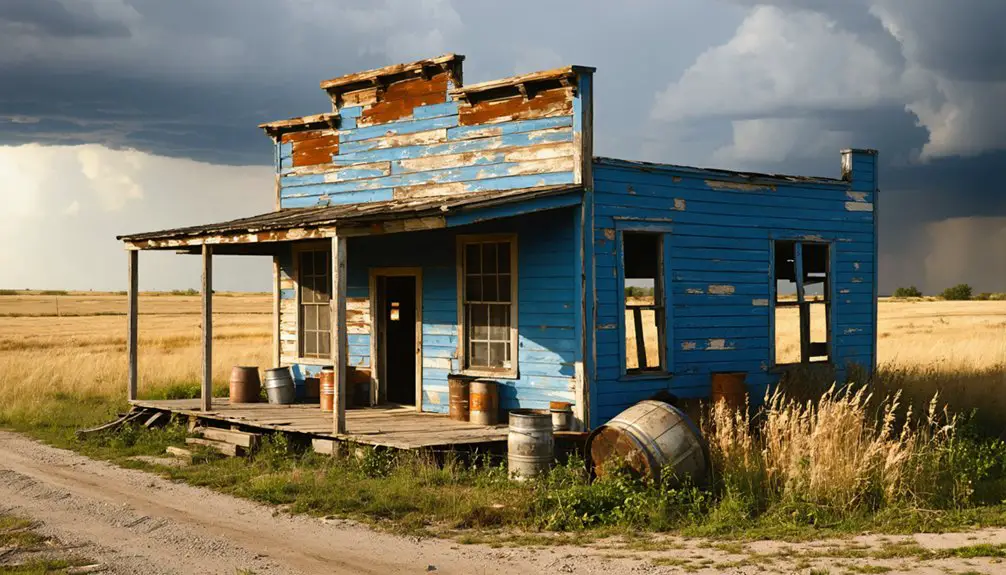You’ll find Coronado, Kansas was a promising prairie settlement established in 1885, featuring the Hotel Vendome and numerous stores. The town’s fate turned during a violent county seat war with rival Leoti, culminating in a deadly shootout on February 27, 1887. Notable figures like Wyatt Earp and Bat Masterson attempted to restore order, but Coronado couldn’t recover. By 1899, the post office closed, leaving behind a fascinating tale of frontier ambition and conflict.
Key Takeaways
- Coronado was established in 1885 in Kansas and named after explorer Francisco Vasquez de Coronado who explored the region.
- A violent shootout with rival town Leoti in 1887 over county seat status marked the beginning of Coronado’s decline.
- The town’s post office closed in 1899, officially marking Coronado’s transition into a ghost town.
- Early settlers built homes using local Smoky Hills stone and relied on community cooperation for survival.
- The once-thriving town reached approximately 175 residents by 1895 before declining during conflicts and the 1930s Dust Bowl.
Birth of a Prairie Settlement (1885)
As settlers pushed westward into the untamed Kansas prairie, the town of Coronado emerged in 1885, strategically positioned in what would become Wichita County. Named after Spanish explorer Francisco Vasquez de Coronado, the settlement quickly attracted early settlers seeking their fortunes in the promising agricultural lands. The town’s namesake had led Spanish expeditions through Kansas nearly 350 years earlier searching for the fabled Seven Cities of Cibola.
Within three months, you’d have witnessed remarkable progress as residents constructed the Hotel Vendome, establishing a foothold in the region.
By March 1887, despite agricultural challenges, the town boasted an impressive array of stores and finer homes than its neighbor, Leoti. Coronado’s establishment coincided with a period of “claim fever,” as speculators and pioneers rushed to stake their claims in western Kansas.
The settlement’s post office, established in 1886, served as a crucial link to civilization for these determined frontier residents. Like other Kansas settlements of the era, severe drought in the 1890s devastated the community’s early promise of growth and prosperity.
The Fierce Battle for County Seat Status
You’ll find Coronado’s tragic demise rooted in its fierce battle with Leoti for the Wichita County seat, a competition that inflamed tensions between the rival towns throughout 1886 and early 1887.
The conflict reached its bloody climax on February 27, 1887, when hired gunmen from Leoti engaged in a deadly shootout with Coronado residents, resulting in multiple casualties and effectively crushing Coronado’s hopes of becoming the county seat. The site is now listed among other place name disambiguation entries due to its historical significance. Like the organized fraudulently Stevens County, the legitimacy of the county’s organization faced intense scrutiny.
After losing this violent struggle, Coronado’s population rapidly dwindled, and by 1899 its post office closed, marking the settlement’s final descent into ghost town status.
Bitter Rivalry Turns Violent
While many frontier towns experienced rivalry, the battle between Coronado and Leoti for Wichita County seat status stands as one of the American West’s most violent political conflicts.
The violent nature of county seat wars was also seen in Stevens County where the Haymeadow Massacre occurred between rival towns.
Cultural tensions and economic motivations drove both towns to extreme measures as they competed for settlers and influence.
The conflict reached its bloody climax in February 1887 when a shootout erupted between the rival towns.
These county seat conflicts were so significant that Garfield County dissolved entirely due to similar disputes between its towns.
You’ll find that both sides had enlisted formidable support – Leoti brought in armed “boosters” from nearby areas, while Coronado secured the backing of legendary figures like Wyatt Earp, Bat Masterson, and Doc Holliday.
The confrontation proved to be the bloodiest county seat fight in Western history, drawing national attention and coverage from the New York Times, which dubbed it the “Cowboy War in Kansas.”
The Deadly Shootout
The deadly showdown between Coronado and Leoti reached its violent peak on February 27, 1887, when a cold Sunday afternoon erupted into one of the bloodiest county seat battles in Western history. The violence began when William Rains demanded beer at a Coronado saloon, leading to a rapidly escalating confrontation. Similar to the Talbot Cowboy Shootout, the incident started with a disturbance at a local establishment before turning deadly. Like the Fort Atkinson before it, the town would ultimately be abandoned.
Here’s what made this shootout notorious:
- Multiple casualties and flowing blood marked the brutal clash
- Hired gunmen from both towns exchanged fierce gunfire
- The shootout’s aftermath brought Wyatt Earp and Bat Masterson to restore order
- The incident showcased the harsh reality of frontier justice
- Coronado never recovered, eventually becoming a ghost town
In the end, Leoti emerged victorious as the county seat, while most of Coronado’s buildings were dismantled and moved to the winning town.
Legacy of Failed Ambitions
Behind Coronado’s violent demise lay a complex struggle for political legitimacy that began in 1885.
You’ll find that Coronado’s failed dreams stemmed from its desperate bid to become Wichita County’s seat, pitting it against rival Leoti in a battle that would define both towns’ futures.
When roughly 400 Coronado voters abstained from the February 1886 election, they sealed their town’s fate.
The political strife that followed saw the closure of Coronado’s post office by 1899, marking its descent into ghost town status.
Much like the fierce rivalry between Eminence and Ravanna, these bitter county seat disputes often required law enforcement intervention to maintain order.
What was once a symbol of frontier ambition now lies buried beneath farmland, serving as a stark reminder of how county seat wars shaped the American West.
The town’s collapse exemplifies the fierce competition that could make or break frontier communities.
Notable Lawmen and Wild West Legacy
During Coronado’s tumultuous county seat war of 1887, legendary lawmen and gunfighters from Dodge City descended upon the small Kansas town, forever linking it to Wild West history.
The violent struggle between Coronado and Leoti brought some of the era’s most infamous figures into the fray, cementing both towns’ places in frontier lore. Three men died during the heated February 1887 confrontation.
- Wyatt Earp and Bat Masterson joined Leoti’s faction as prominent enforcers
- Doc Holliday and Luke Short supported Coronado’s claim with their deadly reputations
- Bill Tilghman and Jim Masterson added their gunfighting prowess to the conflict
- The Sughrue brothers brought additional muscle to Coronado’s cause
- A famous photograph captured these lawmen outside the Wichita County Bank
This bloodiest of Kansas county seat wars garnered national attention, with newspapers from New York to San Francisco chronicling the lawmen’s violent exploits.
Life in Early Coronado Township
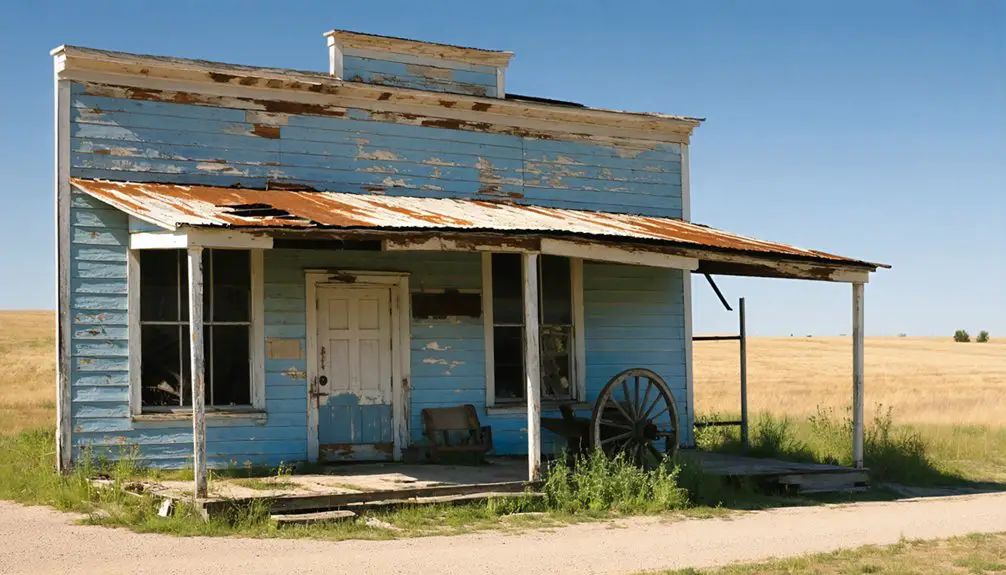
Life in early Coronado Township emerged in 1855 when pioneering settlers established their first permanent homes on mixed-grass prairie lands previously inhabited by Pawnee and Comanche tribes.
You’d have found these early settlers adapting to frontier life by developing a mix of hunting and early agriculture, with precipitation of 20-30 inches supporting their crops of corn, beans, and squash.
Community cooperation proved vital as settlers built homes using local materials from the Smoky Hills’ limestone and sandstone formations.
Working together, pioneers created shelter from Smoky Hills stone, turning raw limestone and sandstone into homes through shared effort.
You’d have witnessed neighbors joining forces for hunting expeditions, crop planting, and construction projects.
The settlers learned to work alongside Native Americans, adopting their agricultural techniques while establishing their own permanent settlements near important water sources like the Arkansas River.
Spanish Explorer’s Connection to the Land
The township’s name traces back to Francisco Vásquez de Coronado, who led Spain’s first major expedition through the Kansas region in 1541.
You’ll find his Spanish influence deeply woven into the area’s history, as he ventured across these plains searching for the mythical city of Quivira.
- Followed the Arkansas River with Wichita guide Ysopete, making camp near present-day Dodge City
- Interacted peacefully with local Wichita tribes, discovering their agricultural settlements and grass houses
- Tortured and executed his Pawnee guide El Turco for false claims about golden treasures
- Expanded Spain’s territorial claims while attempting to convert indigenous peoples to Christianity
- Documented the region’s geography and native settlements, dispelling myths of wealthy cities
Though Coronado left without finding riches, his expedition marked Kansas’s first documented European contact.
Geographic Features and Natural Landscape
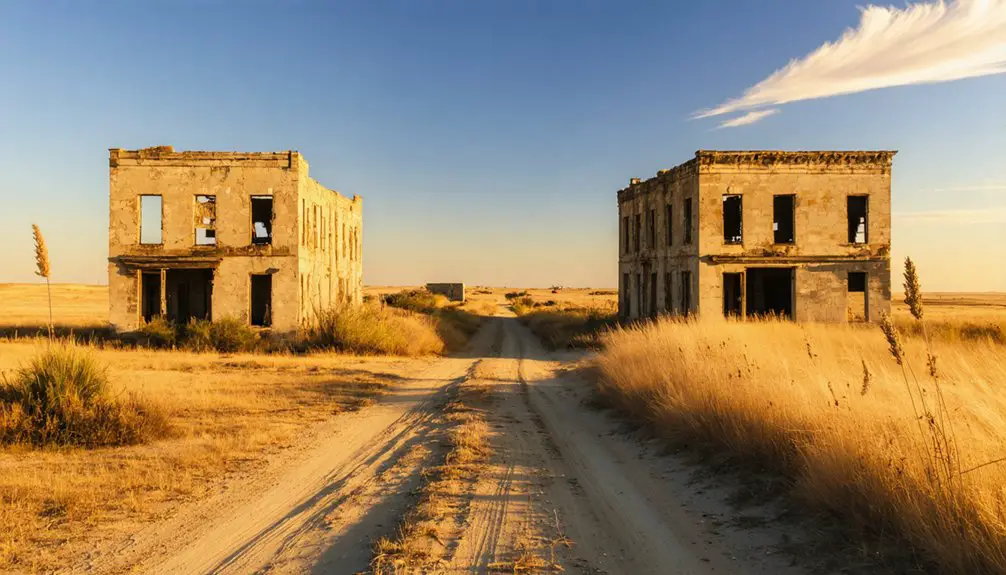
You’ll find Coronado’s natural setting characterized by gently rolling prairie plains punctuated by the dramatic Dakota sandstone buttes that rise from the landscape.
These buttes, remnants of ancient Cretaceous seas, stand as prominent landmarks with their distinctive flat tops and erosion-resistant caps.
The area’s defining feature is the Smoky Hill River Valley, which meanders through the terrain and historically provided water resources for early settlements.
Prairie and Rolling Plains
Kansas’s diverse prairie landscape surrounding Coronado encompasses three distinct grassland types: shortgrass, mixedgrass, and tallgrass prairies.
You’ll find these prairie ecosystems stretching across rolling plains that range from 700 to 4,135 feet in elevation, creating a dynamic landscape that’s shaped by the region’s natural features.
- The Flint Hills dominate with their rocky terrain and native tallgrass prairies
- Fertile but shallow soils support diverse grass species like bluestem and buffalo grass
- Eastern regions feature woodland savannas along the Osage Plains
- River bottoms harbor the area’s limited forest growth
- Western sections evolve into vast, open flatlands of the High Plains
The varied topography includes hills, valleys, and steep slopes, creating a rugged terrain that’s historically supported both wildlife and agricultural activities.
Dakota Sandstone Buttes
Rising dramatically above the rolling prairie landscape, Dakota Sandstone buttes stand as enduring monuments to ancient geological processes that shaped central Kansas.
You’ll find these towering formations rising about 300 feet above the surrounding valleys, their flat tops capped by erosion-resistant Dakota geology that’s roughly 100 million years old.
As you explore the region from Rice County to Washington County, you’ll encounter impressive landmarks like Coronado Heights and Pawnee Rock, where sandstone erosion has carved out distinct features over millions of years.
These buttes represent remnants of ancient Cretaceous seas, where sand and debris once collected. While softer rocks around them have worn away, the hardy Dakota Sandstone caps have preserved these majestic sentinels of the plains.
Smoky Hill River Valley
As the Smoky Hill River carves its 575-mile path through Colorado and Kansas, it shapes a distinctive valley that spans 3 to 3.5 miles wide and straddles two major physiographic provinces.
The river’s flow has sculpted an impressive landscape where you’ll find a rich river ecology amidst dramatic geological formations.
- East-facing escarpments showcase layers of hard limestone and sandstone
- Rolling hills and mesas dominate the Smoky Hills terrain
- Dakota Formation sandstones create notable buttes in the eastern region
- Greenhorn Limestone and Niobrara Chalk form striking central and western hills
- Ancient Cretaceous deposits reveal a time when Kansas lay underwater
You’re witnessing millions of years of erosion that’s carved these rock formations into wide, flat valleys punctuated by prominent landmarks like Castle Rock and Monument Rocks, where river valley sediments tell a story of continuous geological change.
Population Rise and Eventual Decline
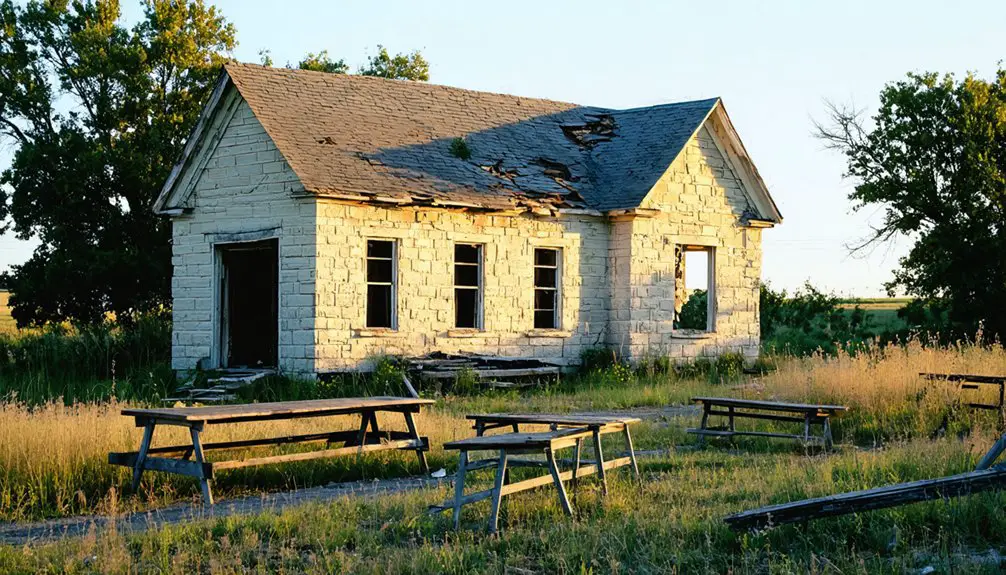
During the late 19th century, Coronado experienced significant population growth alongside its twin town Leoti, with census records showing approximately 175 residents in the township by 1895.
Census data reveals Coronado and neighboring Leoti grew rapidly in the 1890s, reaching a combined population of 175 residents.
The settlement patterns reflected typical Great Plains expansion, as diverse communities including early African American families established roots in the area by 1900.
You’ll find that Coronado’s demographic changes followed a familiar trajectory – after reaching its peak in the late 1880s, the population began declining during the 1930s Dust Bowl era.
Economic hardships, farm foreclosures, and lack of diversification pushed residents to seek opportunities elsewhere.
The mid-20th century brought further challenges when housing demolition and urban renewal projects displaced established communities, accelerating the town’s shift toward ghost town status.
Archaeological Discoveries and Heritage
You’ll find fascinating archaeological evidence of Spanish presence in Coronado’s ghost town through the discovery of chain mail fragments and military artifacts that match those used during the 16th-century expedition.
The area contains numerous Native American sites featuring pottery sherds, worked stone tools, and burial mounds that date to the period of Spanish contact.
Several historic structures from the settlement period have been preserved and mapped, providing tangible connections to both indigenous and European occupation of the region.
Spanish Chain Mail Discovery
Between 1881 and 1888, archaeologists made a remarkable discovery in central Kansas when they unearthed the first fragments of Spanish chain mail near Lindsborg and Rice County.
These Spanish artifacts revealed a rich history of exploration and cultural exchange, with multiple chain mail pieces found through the decades, particularly near Cow Creek.
Chain mail analysis points to several possible origins:
- Coronado’s 1540s expedition left armor behind due to peaceful indigenous relations
- The ill-fated Humana and Bonilla party of 1594 abandoned gear after violent encounters
- Unique weave patterns suggest distinct manufacturing origins
- Pieces align chronologically with Spanish colonial period
- Artifacts demonstrate wider Spanish presence across the American Southwest
You’ll find these fascinating pieces displayed at the Coronado Quivira Museum in Lyons, Kansas, alongside other Spanish Colonial artifacts.
Native American Artifact Sites
The rich archaeological landscape around Coronado extends far beyond Spanish artifacts, encompassing numerous Native American sites that tell a deeper story of the region’s heritage.
You’ll find distinctive council circles near Lindsborg and Lyons, featuring central mounds 20-30 yards in diameter surrounded by concentric ditches. These ceremonial structures, dating from 1475 to 1700, demonstrate the cultural significance of Wichita settlements.
The artifact significance spans multiple eras, with discoveries including pottery shards, stone tools, and preserved corn seeds that reveal the agricultural prowess of indigenous peoples.
The sites between the Smoky Hill and Arkansas Rivers showcase how native trails evolved into major trade routes.
Today, this cultural heritage faces preservation challenges, with ongoing efforts to protect these irreplaceable archaeological treasures from erosion and development.
Historic Structure Preservation
While time has taken its toll on Coronado’s original structures, preservation efforts continue through local museums and historical associations.
You’ll find the town’s historic architecture documented through photographs and artifacts at both the Coronado Historical Museum and Seward County Coronado Museum, where the story of this once-thriving settlement lives on.
Key preservation challenges include:
- Harsh weather conditions causing rapid deterioration of remaining structures
- Original buildings being relocated to neighboring towns
- Limited resources for maintaining archaeological sites
- Wind erosion affecting the Dakota Sandstone formations
- Loss of original settlement fabric due to dismantling
The museums use a restored 1918 family home to showcase local history, while maintaining extensive photographic archives and archaeological findings that help interpret Coronado’s distinctive architectural heritage and brief but significant existence.
WPA Projects and Historic Preservation
During the Great Depression, New Deal initiatives like the Works Progress Administration (WPA) played an essential role in Kansas’s economic recovery, though Coronado’s specific involvement remains poorly documented.
WPA projects throughout Kansas focused on infrastructure development, including road construction and public building improvements, while providing much-needed employment opportunities to rural communities.
While the Kansas Historical Society continues its efforts to preserve historical sites across the state, ghost towns like Coronado face unique challenges.
You’ll find that limited resources, physical decay of structures, and lack of documentation make preservation particularly difficult.
However, community-led initiatives remain crucial for protecting these historic locations.
The preservation of Coronado’s remaining structures depends heavily on securing adequate government support and raising awareness about its cultural significance.
Modern-Day Remnants and Historical Sites
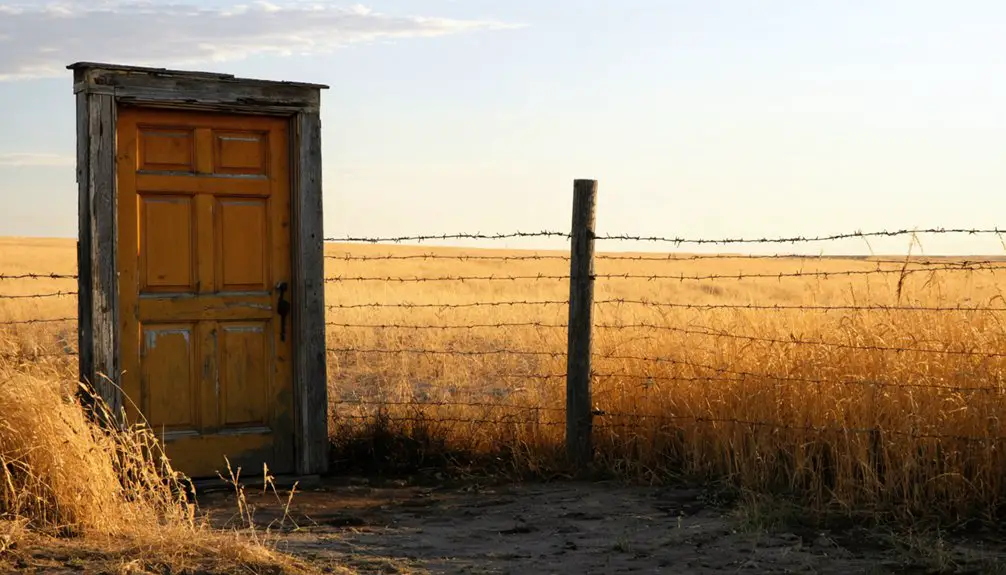
Located in the historic 1918 Lee Larrabee family home, Seward County’s Coronado Museum stands as a central repository for the region’s cultural heritage.
You’ll discover original oak staircases and paneled interiors that transport you back to pioneer life, while exhibits showcase the area’s rich Native American history and European exploration.
- Don Rash’s special Native American collection highlights the region’s indigenous cultural heritage
- Natural grounds feature native plants like tamarack and sand hill plums
- Coronado Heights offers panoramic views from its 300-foot sandstone bluff
- Local ghost towns maintain partial structures and landmarks
- Community engagement continues through interpretive signage and educational activities
The museum and surrounding sites serve as living connections to the past, from Coronado’s 1541 expedition to the Swedish settlement of Lindsborg, preserving stories of exploration and settlement across the Kansas plains.
Frequently Asked Questions
What Role Did Native American Tribes Play in Coronado’s Development?
Like seeds scattered across fertile plains, you’ll find tribal influence shaped Coronado’s path through trade networks, while cultural exchange with Wichita and Pawnee tribes transformed Spanish goals from conquest to commerce.
Are There Any Surviving Photographs of Coronado During Its Prime?
You won’t find conclusive photographic evidence from Coronado’s prime period. While historical documentation exists at the Seward County Coronado Museum, there’s no verified surviving photography from the town’s 1885-1887 peak.
What Happened to the Original Residents After Coronado Became Abandoned?
You’ll find most original residents moved to Leoti after the ghost town’s collapse, while others scattered to nearby farms and communities, seeking economic opportunities and following relocated government services.
Did Any Businesses or Industries Briefly Flourish in Coronado?
Like a flash in the pan, you’d have seen numerous business establishments spring up, including the Hotel Vendome and 100 stores, but industrial growth fizzled within months amid unstable speculation.
Can Visitors Legally Explore or Metal Detect in Coronado Today?
You’ll need explicit landowner permission and proper permits due to strict exploration regulations. Metal detecting laws restrict artifact removal, and you must report any historical finds to authorities.
References
- https://legendsofkansas.com/coronado-heights-kansas/
- https://lostkansas.ccrsdigitalprojects.com/sites/lostkansas/files/private_static/2022-12/LT_WH_Coronado_Harkness.pdf
- https://en.wikipedia.org/wiki/Coronado
- https://visitliberal.com/coronado-museum/
- https://geokansas.ku.edu/coronado-heights
- https://simple.wikipedia.org/wiki/Coronado
- https://fhsuguides.fhsu.edu/kansasheritage/fordcounty
- https://www.gutenberg.org/files/65593/65593-h/65593-h.htm
- https://www.visitoldmeadecounty.com/jasper-/sullivans-history-of-meade-county
- https://www.legendsofamerica.com/ks-stevenscountywar/
